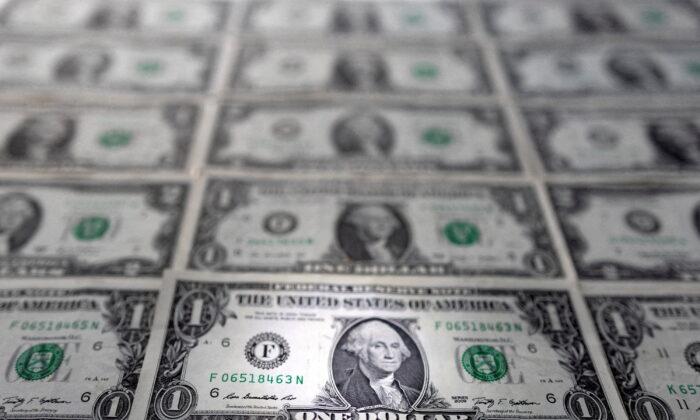LONDON—The dollar edged lower on Monday but remained close to Friday’s six-week high, as a recent flurry of positive economic data reinforced market expectations of tighter monetary policy from the Federal Reserve.
The U.S. dollar index, which measures it against six other major currencies, slipped 0.14 percent to 103.83, though is up almost 1.8 percent for the month, keeping it on track for its first monthly gain since last September. It hit a six-week high of 104.67 on Friday.
Liquidity is expected to be thin on Monday, with U.S. markets closed for Presidents’ Day.
A slew of data out of the world’s largest economy in recent weeks pointing to a still-tight labor market, sticky consumer prices, robust retail sales, and higher producer prices, have raised expectations that the U.S. central bank has more to do in taming inflation, and that interest rates would have to go higher.
But with markets now expecting the Fed funds rate to peak just under 5.3 percent by July, analysts said the move in the dollar may have run its course for now.
“The dollar has had quite a big move this month on the back of rates repricing and the question is how much further that’s going to run,” said Chris Turner, global head of markets at ING.
“I‘d say the majority of what we’re calling a ’corrective rally' in the dollar has been seen,” Turner added.
Hawkish comments from Fed officials have also underpinned the U.S. dollar, as they signaled interest rates would need to go higher in order to successfully quash inflation.
Similarly, two European Central Bank (ECB) policymakers said on Friday that interest rates in the eurozone still have some way to rise, pushing up market pricing for the peak ECB rate.
The euro was last little changed at $1.0694, just above Friday’s six-week low of $1.06125.
“We think the U.S. disinflation process will have another leg in the second quarter, while in Europe, inflation is likely to be stickier,” ING’s Turner said.
“Euro rates are probably likely to stay at higher levels, whereas we think dollar rates will more easily turn lower,” Turner added, which he said could support the euro in the first half of the year.
The dollar was flat against the yen at 134.18. It hit a two-month high of 135.12 yen on Friday.
The Australian dollar rose 0.4 percent to $0.6909 ahead of the minutes from the Reserve Bank of Australia’s latest policy meeting on Tuesday.
The kiwi fell 0.2 percent to $0.6231, ahead of a Reserve Bank of New Zealand (RBNZ) rate decision on Wednesday.
The RBNZ is expected to scale down its tightening campaign only slightly, with a half-point interest rate increase to 4.75 percent.
“With inflation so high ... not staying the course could mean even higher interest rates are required down the track,” said analysts at ANZ.
In Asia, China kept its benchmark lending rates unchanged for a sixth straight month in February, as expected, with the world’s second-largest economy showing more signs of recovery from a pandemic-induced slump.
The offshore yuan was last marginally higher at 6.8643 per dollar, while the onshore yuan last bought 6.8580 per dollar.





